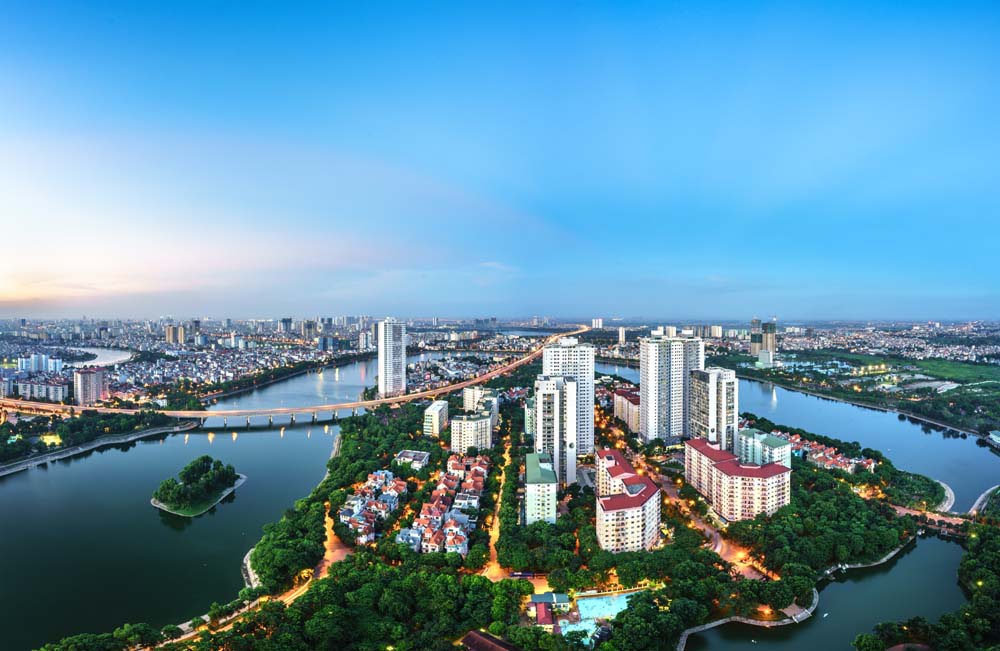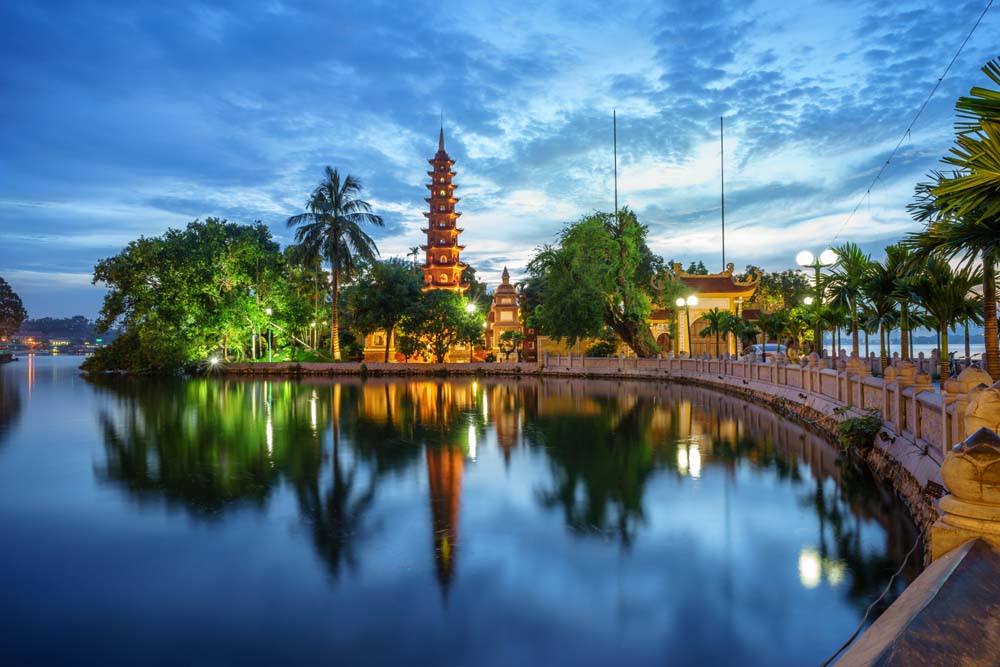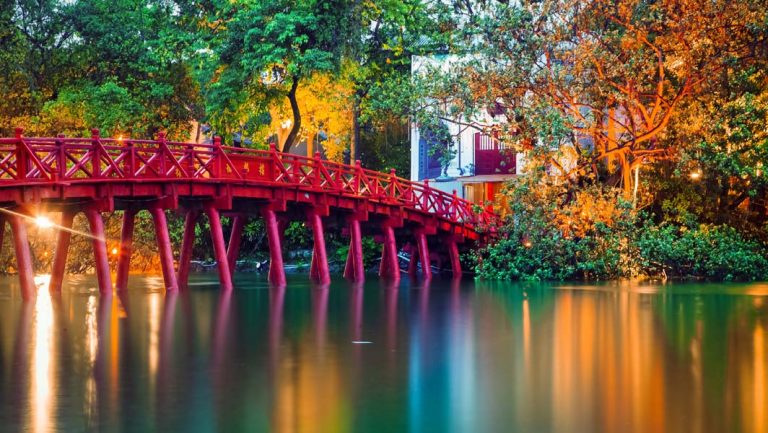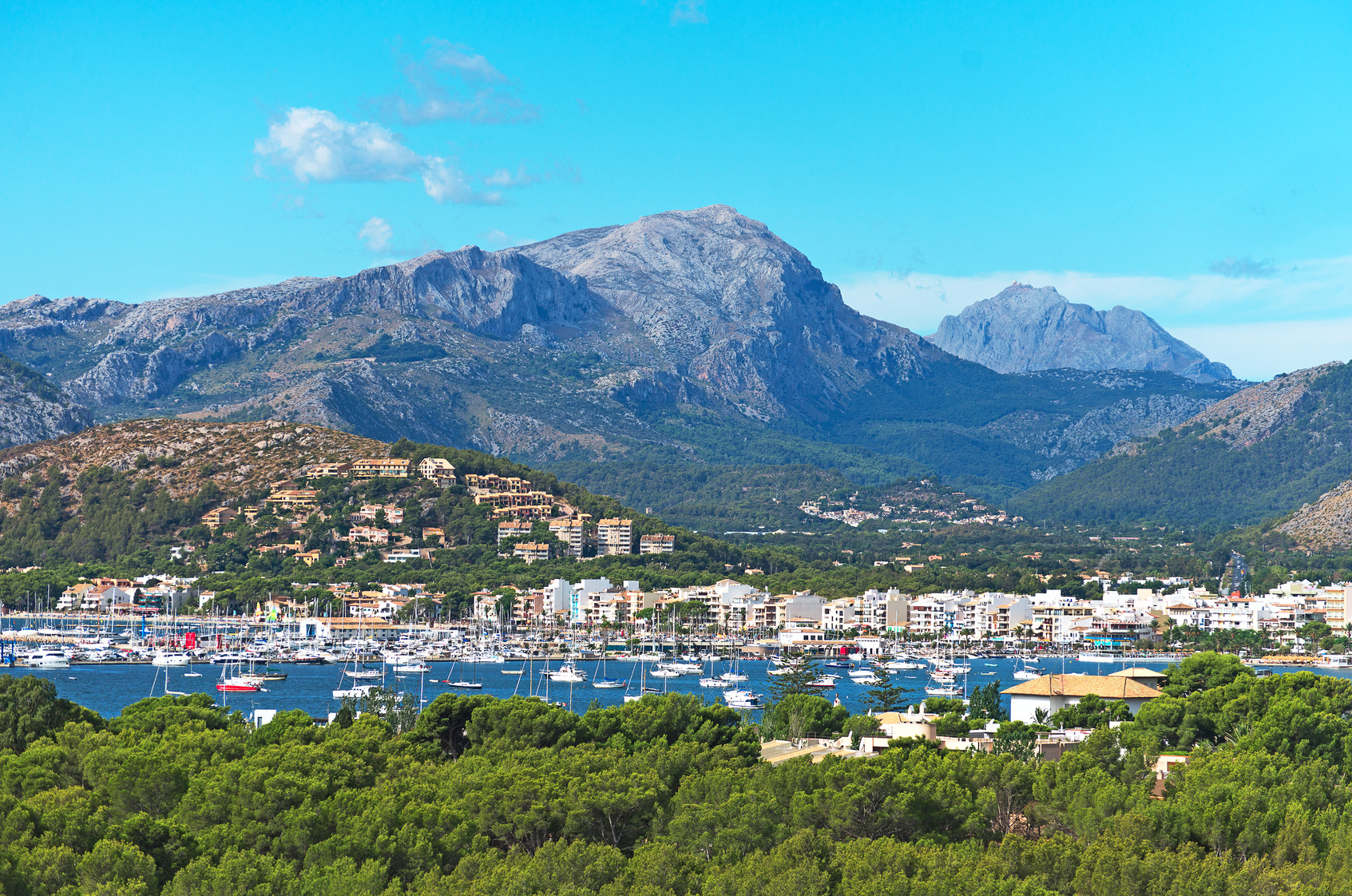Standing close to Laos and Chinese borders in the north of Vietnam, Hanoi is the country’s historic capital and is a popular tourist destination with around 5 million annual visitors. Hanoi has a population of almost 8 million people and is the country’s 2nd largest city after Ho Chi Minh City (formerly known as Saigon) which lies some 1500km to the south. In spite of its size the majority of tourists are concentrated in the French Quarter and Old Quarter whilst visiting attractions in the nearby Ba Dinh District.
The city has plenty temples, colonial buildings and excellent museum and is a great base from which to visit the UNESCO World Heritage Site of Ha Long Bay. The best time to visit Hanoi is between September and November (autumn) or between March and April (spring). These periods usually avoid the heavy rains of the wet season and enjoy moderate daily temperatures.

Arriving in Hanoi
Hanoi Airport: Air travellers visiting Hanoi will land at Noi Bai International Airport which lies 30km north of the city. The airport is a hub for Vietnam Airlines and welcomes many international flights from mainly Asian destinations. There are also many domestic arrivals including flights from Ho Chi Minh City which is one of the world’s busiest routes.
Hanoi Airport Transfers: Some airlines including Vietnam Airlines, VietJet and Jetstar offer private minibus transfers into the centre of Hanoi. Alternatively, there’s a convenient express bus service (no. 86) which departs from outside the two terminals and delivers tourists to a stop in front of the Post Office near Hoan Kiem lake and the Old Quarter. There are also public buses but they tend to be very slow.

Taxis are available from the airport but rates aren’t fixed and drivers are notorious for overcharging tourists or even taking them to the wrong hotel. Far more convenient is to pre-book a private transfer from Hanoi Airport. Prices are fixed at the time of booking and your driver will be waiting for you on arrival.
Where to Stay: Most visitors choose to stay within close proximity of the city centre (Hoan Kiem) where a huge choice of accommodation is available. Budget travellers will find many cheap guesthouses and hostels all around the Old Quarter whilst wealthier visitors can book luxury hotels in beautiful colonial buildings located in the French Quarter. Travellers who would prefer to avoid the crowded streets and noise of the central area might prefer to head for the Ba Dinh District which is home to many of the city’s historical attractions. This neighbourhood offers a good choice of mid-range accommodation and some nice restaurants but there isn’t a lot to do in the evening.
Getting Around: For travelling any significant distance around the city it’s best to take a taxi. Unfortunately, there are many untrustworthy drivers in Hanoi with countless scams targeting tourists. Highly recommended is to download the Grab app which is South-East Asian version of Uber. Travelling on the back of a motorbike taxi is a common way to get around in Hanoi and cyclos are popular for short distances. No matter what form of transport you choose you must be sure to confirm prices before beginning a journey as the city has more than its fair share of rip-off merchants.
Tourist Attractions in Hanoi
Old Quarter of Hanoi: Made up of 36 streets this traditional, downtown neighbourhood is where visitors will spend much of their time. The area offers plenty accommodation options and is home to countless cafés and restaurants together with some of the city’s main tourist attractions. Highlights of these include a number of Buddhist temples, Saint Joseph Cathedral, Maison Centrale, Hoan Kiem Lake, the Thang Long Water Puppet Theatre and the lively Weekend Night Market. The Old Quarter is closed to motorbikes and vehicles in the evening and at weekends which makes it a great place to wander around without fearing for your life as is the case in some other parts of Vietnam!

Hoan Kiem Lake: Located just a short walk from the Old Quarter this urban lake provides a welcome respite from the hustle and bustle of downtown Hanoi. It is frequented by tourists and locals alike who casually stroll around its perimeter and visit the Ngoc Son Temple. This iconic pagoda stands on the tiny Jade Island which is reached by means of an historic wooden walkway known as the Rising Sun Bridge. It only takes about 20 minutes to walk around the lake and there are plenty benches from which you can relax and try to spot the giant turtles which live in its waters.
Ho Chi Minh Mausoleum: Standing in the centre of Ba Dinh Square some 2.5km west of the Old Quarter this mausoleum is the final resting place of Ho Chi Minh (1890-1969). Inspired by Lenin’s Mausoleum in Moscow this large, eery structure houses the embalmed body of the former President in a glass coffin protected by armed guards. Visitors are allowed to enter the mausoleum to see the remains of the revered leader who is affectionately referred to as ‘Uncle Ho’ by the Vietnamese people. The mausoleum closes for a couple of months late in the year when the embalmed body is supposedly sent to Russia for preservation work.
One Pillar Pagoda: Just a few minutes’ stroll from the mausoleum this beautiful Buddhist temple dating back to the 11th century is one of Hanoi’s most revered sites. It has been rebuilt numerous times over the years, most recently in the 1950s after it was destroyed by the French at the end of the First Indochina War. The structure is built from wood in the shape of a lotus blossom and is one of the country’s most iconic temples along with the Perfume Pagoda which lies south of Hanoi and is a popular day excursion from the capital.
Imperial Citadel of Thăng Long: Just 2km west of the Old Quarter the 11th century Hanoi Citadel served as the seat of Vietnamese Government around 800 years before the Nguyễn dynasty moved the capital to Huė in the early 19th century. Subsequently most the citadel’s palaces fell into a state of disrepair and had to be knocked down. Recent excavations of the site have revealed a remarkable selection of ancient palaces, associated infrastructure and artefacts dating back to the 6th century such that in 2010 the central sector of the complex was listed as a UNESCO World Heritage Site.
Temple of Literature: Located less than 2km south of Ba Dinh Square this former university building dating back to the 11th century stands amongst numerous attractive courtyards and gardens. It originally served as an exclusive place of learning for society’s elite before opening its doors to the general population. Built in traditional Vietnamese style this beautiful cultural site is recognised nationally as a tribute to education and literature in the country.
Hoa Lo Prison Memorial: Better known as ‘Maison Centrale’ this fortress was originally used by the French as a jail for Vietnamese political campaigners in the early 20th century. Some prisoners were executed by means of the guillotine which is on display at the museum today. The site later served as a prison for American pilots during the Vietnam War (also known as the ‘American War’ in Vietnam!) who, in spite of the horrific conditions, are said to have referred to it as the ‘Hanoi Hilton’. Most of the structure was pulled down in the 1990s but remains an interesting attraction for visitors with an interest in the history of the war. The prison is located next to the French Quarter, just a short distance to the south-west of Hoan Kiem Lake.
Best Day Excursions from Hanoi
Perfume Pagoda: Visitors to the One Pillar Pagoda is Hanoi who’d like to learn more of the region’s Buddhist culture should book an excursion to the Perfume Pagoda which lies 60km south of the city in the Huong Son Mountains. Whilst the origins of this temple can be traced back to the 15th century local folklore claims that a Buddhist monk came here to meditate more than 2000 years ago. The Perfume Pagoda is the largest of many Buddhist temples located within this mountainous region. It is reached by means of a small boat which is included as part of the tour package from Hanoi. Pilgrims to the cave structure touch the different stalagmites and stalactites in the belief that they will bestow on them particular blessings whether it be good health and prosperity or a plentiful rice harvest.
Ha Long Bay: Ha Long Bay is a UNESCO World Heritage Site located 175km east of Hanoi. Whilst an overnight cruise of the Bay is preferable it is possible for those with limited time to take a day trip from the capital. Halong Bay is made up of thousands of limestone karsts which present magnificent seascapes which are often named after the animals that they resemble such as Khi Islet (Monkey Island). There is evidence of human existence in the region dating back to prehistoric times although today’s population amounts to around 1500 people who live in floating houses in a handful of fishing villages.
Hoa Lu and Tam Coc: Located amongst a landscape of rolling hills some 100km south of Hanoi is Hoa Lu which was the country’s capital in the 10th and 11th centuries. Tour groups from Hanoi usually spend a short time here as little remains of the ancient city. The highlight of the excursion tends to be the boat ride to Tam Coc which travels slowly through a stunning rural landscape of rolling hills, rice fields and karst scenery. Some excursions may include a visit to Trang An which is another beautiful spot near Tam Coc where boat trips enter the caves beneath the limestone karsts.
About Shuttle Direct
Shuttle Direct is one of the world’s most established and respected airport transfer providers. Our services are available throughout Europe as well as in North Africa, the Middle East, Southeast Asia and South America. Our friendly local drivers will ensure your safe, economical and convenient passage to and from the airport, cruise terminal or major train station of your choice with a minimum of fuss. Book your transfer with our easy to use online booking system and leave the rest up to us!




